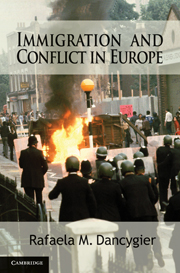Book contents
- Frontmatter
- Contents
- List of Figures and Tables
- Acknowledgments
- PART I GENERAL INTRODUCTION AND THEORETICAL FRAMEWORK
- PART II INTRODUCTION TO PART II
- PART III INTRODUCTION TO PART III
- PART IV INTRODUCTION TO PART IV
- 7 Economic Integration, Political Exclusion, and Immigrant Conflict in Germany
- 8 Immigration and Conflict across Countries
- 9 Conclusion
- Appendix A Coding Large-Scale Instances of Immigrant–Native and Immigrant–State Violence
- Appendix B Data and Variables: Immigrant Turnout
- References
- Index
- Titles in the series
8 - Immigration and Conflict across Countries
Published online by Cambridge University Press: 17 November 2010
- Frontmatter
- Contents
- List of Figures and Tables
- Acknowledgments
- PART I GENERAL INTRODUCTION AND THEORETICAL FRAMEWORK
- PART II INTRODUCTION TO PART II
- PART III INTRODUCTION TO PART III
- PART IV INTRODUCTION TO PART IV
- 7 Economic Integration, Political Exclusion, and Immigrant Conflict in Germany
- 8 Immigration and Conflict across Countries
- 9 Conclusion
- Appendix A Coding Large-Scale Instances of Immigrant–Native and Immigrant–State Violence
- Appendix B Data and Variables: Immigrant Turnout
- References
- Index
- Titles in the series
Summary
The previous chapters have shown how national immigration frameworks can shape and interact with local political economies and immigrant political behavior to determine patterns of immigrant conflict. Comparing across countries, we have seen that Germany's postwar guest-worker regime was structured in ways that limited competition over material resources between immigrants and natives at the local level. Comparatively stringent immigration and settlement regulations meant that immigrants were less likely to confront resource shortages upon arrival while the economic rationale of guest-worker migration prompted the state to encourage or force the departure of those migrants whose labor was no longer needed. As the initial rules that had guided postwar migration gradually faded, relative economic integration without political incorporation became the norm. In Great Britain, by contrast, the state played a far less interventionist role in recruiting and settling immigrant labor. As a result, economic competition between immigrants and natives as well as economic deprivation on the part of immigrants has been more common.
Variation in the economic conditions in the local areas of settlement interacts with immigrants' capacity to obtain valued economic goods, and these are the two central variables that explain the incidence of both immigrant–native and immigrant–state conflict. Indeed, differences in conflict outcomes across cities and over time within Great Britain have been as significant as variation across Germany and Great Britain.
- Type
- Chapter
- Information
- Immigration and Conflict in Europe , pp. 261 - 291Publisher: Cambridge University PressPrint publication year: 2010

